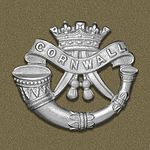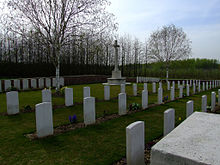- Duke of Cornwall's Light Infantry
-
The Duke of Cornwall's Light Infantry 
Badge of the Duke of Cornwall's Light InfantryActive 1 July 1881 – 5 October 1959 Country  United Kingdom
United KingdomBranch  Army
ArmyType Line Infantry Role Light Infantry Size 1–2 Regular Battalions
1 Militia and Special Reserve Battalion
1–2 Territorial and Volunteer Battalions
Up to 10 Hostilities-only BattalionsGarrison/HQ Victoria Barracks, Bodmin[1] Colors White facings March Quick: One and All The Duke of Cornwall's Light Infantry (DCLI) was an infantry regiment of the British Army from 1881 to 1959. Its lineage is continued today by The Rifles.
The regiment was created on 1 July 1881 as part of the Childers Reforms, by the merger of the 32nd (Cornwall Light Infantry) Regiment of Foot and the 46th (South Devonshire) Regiment of Foot.[2] The DCLI also incorporated the militia and rifle volunteers of Cornwall.[3][4][5]
In 1959 the regiment merged with the Somerset Light Infantry to form the Somerset and Cornwall Light Infantry.[4]
Contents
History
1881–1899
Under the Childers system, one regular battalion of each regiment was to be at a "home" station, while the other was abroad. Every few years, there was to be an exchange of battalions. In the period from the regiment's formation to the outbreak of the Second Boer War the two regular battalions were stationed as follows:
Location of 1st Battalion (ex 32nd Foot)[6] Years Location of 2nd Battalion (ex 46th Foot)[7] Years England and Ireland 1881–1885 Gibraltar 1881–1882 Egypt 1882–1885 Malta 1885–1888 Sudan 1885–1886 India and Burma (fought in Tirah Campaign of 1897) 1888–1900 England and Ireland 1886–1900 1899–1914
In October 1899 war broke out between the United Kingdom and the Boer Republics. The 2nd Battalion arrived in South Africa in the following month, where it took part in minor actions on the western border of the Cape Colony. In February 1900 it became part of the 19th Brigade. It saw action against the Boers at Paardeburg, and in March 1900 entered Bloemfontein. It continued to take part in a series of skirmishes until the end of the war.[8] The 1st Battalion took no part on the war, moving from India to Ceylon in 1900 where its soldiers guarded South African prisoners of war.[6]
Following the war in South Africa, the system of rotating battalions between home and foreign stations resumed as follows:
Location of 1st Battalion (ex 32nd Foot)[6] Years Location of 2nd Battalion (ex 46th Foot)[7] Years South Africa 1902–1906 England 1902–1905 England 1906–1913 Gibraltar 1905–1907 Bermuda 1907–1910 South Africa 1910–1913 Ireland (The Curragh) 1913–1914 Hong Kong 1913–1914 Reserve battalions 1881–1914
The 1881 reorganisation also redesignated the militia and rifle volunteers of Cornwall as battalions of the regiment as follows:[9]
- 3rd (Militia) Battalion (formerly the "Royal Conwall Rangers, Duke of Cornwall's Own Rifles", raised 1760)
- 1st Volunteer Battalion (formerly 1st Cornwall Rifle Volunteer Corps, raised 1860)
- 2nd Volunteer Battalion (formerly 2nd Cornwall Rifle Volunteer Corps, raised 1860)
Neither militia nor volunteer battalions were liable for service outside the United Kingdom. However, during the Second Boer War, both volunteer battalions contributed "Active Service Companies" that reinforced the regular battalions, and were awarded the battle honour "South Africa 1900–1901".[10]
In 1908 reserve forces were reorganised by the Territorial and Reserve Forces Act 1907 (the Haldane Reforms). The militia was renamed the "Special Reserve", with the duty of providing trained recruits in time of war. The volunteer battalions became part of the new Territorial Force, which was organised into 14 infantry divisions which were called upon to serve abroad.[11] On 1 April 1908 the three reserve battalions were accordingly redesignated as the 3rd (Special Reserve), 4th (Territorial Force) and 5th (Territorial Force) Battalions, DCLI.[12]
World War I
The war saw a large expansion of the regiment. This was done in two ways: by the formation of duplicate units to the existing territorial battalions, and by the raising of wartime "New Army" or Service battalions. The following battalions of the DCLI saw active service in the conflict:[13]
Battalion Service 1st Battalion Western Front 1914–1917; Italian Front 1917–1918; Western Front 1918 2nd Battalion Western Front 1914–1915; Macedonian Front 1915–1918 1/4th Battalion India 1914–1916; Aden 1916–1917; Egypt 1917–1918 2/4th Battalion (Formed September 1914) India 1914–1918 1/5th Battalion Remained in UK until 1916. Western Front 1916–1918 6th (Service) Battalion (Formed August 1914) Western Front 1915–1918 (disbanded February 1918) 7th (Service) Battalion (Formed September 1914) Western Front 1915–1918 8th (Service) Battalion (Formed September 1914) Western Front 1915; Mesopotamian Front 1915–1918 10th (Service) Battalion (Cornwall Pioneers) (Formed March 1915) Western Front 1916–1918 Inter War period
Years 1st Battalion[6] Years 2nd Battalion[7] 1919–1922 Ireland 1919–1920 India 1922–1939 India 1920–1921 Iraq 1921–1922 Ireland 1922–1924 Germany (Army of occupation) 1924–1927 Guernsey 1927–1932 England 1932–1935 Gibraltar 1935–1939 England World War II
In 1944 Hill 112 in Normandy acquired the name "Cornwall Hill" after Cornish soldiers of 5th Duke of Cornwall's Light Infantry suffered 320 casualties in the fighting there.
Duke of Cornwall's Light Infantry Regimental Museum
The original barracks in Bodmin houses the regimental museum, founded in 1925. It includes the history of the regiment from 1702, plus a military library. There is a fine collection of small arms and machine guns, plus maps, uniforms and paintings on show. Included in the display are the medals of Harry Patch, the last British survivor of the First World War.[14] and the VC awarded to Herbert Augustine Carter for gallantry in Somaliland in 1903.
Bodmin Parish Church was the regimental place of worship where there are memorials to some of the servicemen and regimental colours from the past.
Literature
Surfing Tommies is a 2009 play by the Cornish author Alan M. Kent which follows the lives of three members of the Duke of Cornwall's Light Infantry on a journey from the mines of Cornwall to the fields of Flanders, where they learned to surf with South African troops.[15]
Notable members
 Sergeant Thomas Edward Rendle, VC
Sergeant Thomas Edward Rendle, VC
Recipients of the Victoria Cross
Eight soldiers of the DCLI were awarded the VC including:
- Lieutenant Philip Curtis (medal displayed in the Museum)
- Thomas Edward Rendle (medal displayed in the Museum)
- Clement Leslie Smith (medal displayed in the Museum)
Others
- Lieutenant-General Arthur Nugent Floyer-Acland CB, DSO, MC, DL (7 September 1885 – 18 February 1980)
- Harry Patch, the last Tommy (d. July 2009)
- Harold Royffe[16]
- Major-General David Tyacke (born 1915 at Breage, Cornwall; d. 2010); Colonel 1957–59 (afterwards Deputy Colonel of the Somerset and Cornwall Light Infantry)[17]
Battle Honours
- From 32nd Regiment of Foot: Rolica, Vimiera, Corunna, Salamanca, Pyrenees, Nivelle, Nive, Orthes, Peninsula, Waterloo, Goojerat, Mooltan, Punjaub, Lucknow
- From 46th Regiment of Foot: Dominica, Sevastopol
- Gibraltar 1704-05, Dettingen, St. Lucia 1778, Tel el Kebir, Egypt 1882, Nile 1884-85, Paardeberg, South Africa 1899-1902
- The Great War (15 battalions): Mons, Le Cateau, Retreat from Mons, Marne 1914, Aisne 1914, La Bassée 1914, Armentières 1914, Ypres 1915 '17, Gravenstafel, St. Julien, Frezenberg, Bellewaarde, Hooge 1915, Mount Sorrel, Somme 1916 '18, Delville Wood, Guillemont, Flers-Courcelette, Morval, Le Transloy, Ancre 1916, Bapaume 1917 '18, Arras 1917, Vimy 1917, Scarpe 1917, Arleux, Langemarck 1917, Menin Road, Polygon Wood, Broodseinde, Poelcappelle, Passchendaele, Cambrai 1917 '18, St. Quentin, Rosières, Lys, Estaires, Hazebrouck, Albert 1918, Hindenburg Line, Havrincourt, Canal du Nord, Selle, Sambre, France and Flanders 1914-18, Italy 1917-18, Struma, Doiran 1917 '18, Macedonia 1915-18, Gaza, Nebi Samwil, Jerusalem, Tell 'Asur, Megiddo, Sharon, Palestine 1917-18, Aden
- The Second World War: Defence of Escaut, Cheux, Hill 112, Mont Pincon, Noireau Crossing, Nederrijn, Opheusden, Geilenkirchen, Rhineland, Goch, Rhine, North-West Europe 1940 '44-45, Gazala, Medjez Plain, Si Abdallah, North Africa 1942-43, Cassino II, Trasimene Line, Advance to Florence, Incontro, Rimini Line, Italy 1944-45
See also
- Duke of Cornwall's Light Infantry officers
- Duke of Cornwall's Light Infantry soldiers
- First DCLI Commonwealth War Graves Commission Cemetery, The Bluff
References
- ^ "The Duke of Cornwall's Light Infantry". British Light Infantry Regiments. 25 September 2008. http://www.lightinfantry.org.uk/regiments/dcli/duke_index.htm. Retrieved 4 April 2010.
- ^ London Gazette: no. 24992. pp. 3300–3301. 1 July 1881.
- ^ Farmer, John S (1901). The Regimental Records of the British Army : a historical résumé chronologically arranged of titles, campaigns, honours, uniforms, facings, badges, nicknames, etc.. London: Grant Richards.
- ^ a b Swinson, Arthur (1972). A Register of the Regiments and Corps of the British Army. London: The Archive Press. ISBN 0-85591-000-3.
- ^ Wickes, H L (1974). Regiments of Foot: A History of the Foot Regiments of the British Army. Reading, Berkshire: Osprey Publishing. ISBN 0-85045-220-1.
- ^ a b c d Mills, T F (3 April 2005). "1st Bn, The Duke of Cornwall's Light Infantry". Land Forces of Britain, The Empire and the Commonwealth. Archived from the original on 21 December 2007. http://web.archive.org/web/20071221053831/www.regiments.org/deploy/uk/reg-inf/032-1.htm. Retrieved 9 April 2010.
- ^ a b c Mills, T F (11 September 2005). "2nd Bn, The Duke of Cornwall's Light Infantry". Land Forces of Britain, The Empire and the Commonwealth. Archived from the original on 21 December 2007. http://web.archive.org/web/20071221233605/www.regiments.org/deploy/uk/reg-inf/046-1.htm. Retrieved 10 April 2010.
- ^ Biggins, David. "Duke of Cornwall's Light Infantry". Anglo Boer War. http://www.angloboerwar.com/units%20imperial/dcli.htm. Retrieved 9 April 2010.
- ^ "The Duke of Cornwall's Light Infantry". British Light Infantry Regiments. 2 December 2007. http://www.lightinfantry.org.uk/regiments/dcli/duke_timeline.htm. Retrieved 9 April 2010.
- ^ "The Duke of Cornwall's Light Infantry". British Light Infantry Regiments. 2 December 2007. http://www.lightinfantry.org.uk/regiments/dcli/duke_tabattalions.htm. Retrieved 9 April 2010.
- ^ Dunlop, John K. (1938). The development of the British Army 1899–1914. London: Methuen. pp. 280–285.
- ^ Order in Council dated 19 March 1908 London Gazette: no. 28121. pp. 2149–2162. 20 June 1908.
- ^ Chris Baker. "The Duke of Cornwall's Light Infantry". The Long, Long Trail. http://www.1914-1918.net/dcli.htm. Retrieved 9 April 2010.
- ^ "WWI veteran's medals go on show". BBC News. 17:52 GMT, Wednesday, 12 August 2009. http://news.bbc.co.uk/1/hi/england/cornwall/8198354.stm. Retrieved 2009-08-13.
- ^ "Surfing Tommies". http://www.thisiscornwall.co.uk/whatson/Hanging-10-trenches/article-947675-detail/article.html.
- ^ "Capt. QM Harold Royffe". Somerset & Cornwall Light Infantry (The). http://www.scli.co.uk/pages/harold_royffe.htm. Retrieved 2009-08-09.
- ^ Independent, The; Viewspaper, May 4th, 2010; p. 9
External links
Categories:- Military units and formations established in 1881
- Infantry regiments of the British Army
- Military of the United Kingdom in Cornwall
- Museums in Cornwall
- Regimental museums in England
- Military history of Cornwall
- British light infantry
- Regiments of the British Army in World War II
- Regiments of the British Army in World War I
- Duke of Cornwall's Light Infantry
- 1881 establishments in the United Kingdom
Wikimedia Foundation. 2010.



